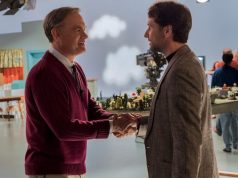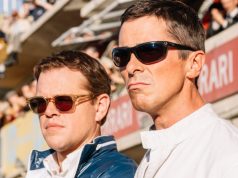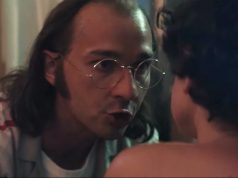Much has been made of Mickey Rourke’s career-reviving performance in “The Wrestler,” where he plays a washed-up Hulk Hogan type trying to make sense of his life outside the ring. As eye-opening as that performance is, I’m also intrigued by the work of the director, Darren Aronofsky, for whom “The Wrestler” is a complete departure — and a completely successful one, too.
Aronofsky’s first three movies, “Pi,” “Requiem for a Dream,” and “The Fountain,” established him as a master of visual poetry, albeit one who is sometimes baffling and obtuse. Those are not necessarily bad qualities — I consider “Requiem” one of the best films of the decade — but they do tend to make Aronofsky an acquired taste. “The Wrestler,” on the other hand, is entirely straightforward in its visual style and story line. The camerawork is intimate, almost documentary-like, and the characters resonate as regular, identifiable people. The film’s genius is in its subtleties, which combine to make it more than just a “Rocky”-style underdog drama. If you look a little deeper, the film has a lot to say about America’s entertainment and celebrity culture, and it tells a poignant story in the process.
Rourke plays Randy “The Ram” Robinson, a major pro-wrestling hero in the 1980s whose best days are now far behind him. Living alone in a trailer in New Jersey, he does small-scale shows on the weekends, where he’s invariably the top dog and can still command some respect from the has-beens and not-yets of his profession. To pay the bills, he works part-time on a grocery store’s loading dock, ignoring the jokes made by his smarmy boss (Todd Barry) about his weekend activities (on his request for more hours: “What, did the price of tights go up?”), and he spends his spare evenings at a strip club, flirting with his favorite, Cassidy (Marisa Tomei). Cassidy’s best days are behind her, too.
As much as possible, Randy prefers to live in the past. He drives an old van and listens to the hair-metal bands from his heyday (he and Cassidy agree that “the ’90s sucked”), and he spends a lot of money on steroids and other enhancements to fight the aging process. But his body has been abused over the years, both in and out of the ring, and he has the scars — and the hearing aid, and the reading glasses — to prove it.
The pinnacle of his career was a now-legendary match in 1989 between him and a character called The Ayatollah (Ernest Miller, a real-life wrestler). The 20th anniversary is coming up, and Randy’s promoter thinks a rematch could be just the thing to help him recapture some of his youth and glory. (The Ayatollah now sells cars in Arizona.) Randy’s health problems, which now include a heart bypass surgery, have led his doctor to urge him away from wrestling, but come on — what else is he gonna do?
That is the film’s central, existential dilemma: What else can a guy like Randy “The Ram” Robinson do? He and Cassidy the stripper are kindred spirits. They both have physically demanding jobs that require stage names and have little use for anyone older than about 30. Neither profession is taken seriously except by its audience, and often not even then. Cassidy doesn’t want to be a stripper forever, though, while Randy is slowly realizing that wrestling is his destiny. “The only place I get hurt is out there,” he says, meaning the world outside the ring.
Which is an ironic thing to say, given how much he gets hurt inside the ring. Aronofsky peers unflinchingly into the world of professional wrestling, bemused by the backstage choreographing and gobsmacked by the torture these guys — especially the up-and-comers — inflict upon themselves for the sake of entertainment. One brutal sequence shows Randy grappling with a sado-masochist called Necro Butcher (a real-life wrestler, born Dylan Summers) and suffering wounds from broken glass, barbed wire, and a staple gun. Cassidy jokingly points out that Randy “The Ram” Robinson is something of a Christ figure — “You have the same hair,” she says, calling him a “sacrificial Ram” — but there’s truth behind it. To misquote Isaiah, Randy was wounded for our enjoyment, he was bruised for our amusement: the chastisement of our bloodlust was upon him; and with his stripes we are entertained.
Aronofsky (working from a lean, well-constructed screenplay by Robert D. Siegel) directs the film with restraint and compassion, never mocking his characters’ career choices or questionable life decisions. He frequently shoots Randy from the back, suggesting the way cameras follow performers as they walk from their dressing rooms to the stage — except that Randy’s stages are a trailer, a meat counter, and a strip club.
The film’s heart and soul are in Rourke’s three-dimensional portrayal of Randy not as a big dumb goon but as a real guy trying to find his purpose in the world. Numerous small touches in his performance (his walk, his voice, his mannerisms) bring the character to life in a way that’s incredibly moving, and I don’t think there’s a single false or contrived moment of “acting” anywhere in the film. Even his attempt to reconnect with his estranged college-age daughter, Stephanie (Evan Rachel Wood), whom he abandoned years ago, doesn’t feel like the cliché it could have been. Randy’s desire for reconciliation stems from his inner goodness. He’s sincere, and he means well. He has a good heart, metaphorically if not physically.
One of the film’s simplest, most memorable scenes has Randy good-naturedly working the deli counter at the grocery store, jesting with customers and generally enjoying himself. You start to think the same thing he’s thinking, which is that he really could leave wrestling behind and live happily as a wage-earner. But once you’ve been a celebrity, the public will always view you that way. If you have the audacity to leave showbiz, you’re a failure. We want you in the limelight, or we don’t want you at all. Randy “The Ram” Robinson is struggling with that harsh truth, and “The Wrestler” brings us along for the heartbreaking journey.
A (1 hr., 49 min.; )





